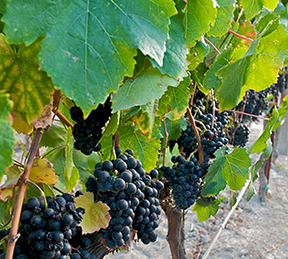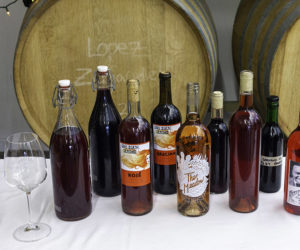 When it comes to winemaking, the choices of a winemaker are far ranging as they ponder the journey from grape to bottle for the particular variety they are working with. The winemaker is intimately involved with this journey; trying to feel out the grape and its best qualities to showcase going forward. At some point in this journey, decisions are made to showcase the complete varietal, or use the varietal to complement a blend.
When it comes to winemaking, the choices of a winemaker are far ranging as they ponder the journey from grape to bottle for the particular variety they are working with. The winemaker is intimately involved with this journey; trying to feel out the grape and its best qualities to showcase going forward. At some point in this journey, decisions are made to showcase the complete varietal, or use the varietal to complement a blend.
Complementing blends is sometimes dictated by the country and region for which the wine is being made, but in New World winemaking, the winemaker has a choice, and in recent years, has chosen to showcase Petit Verdot as a varietal as it is able to mature consistently year to year in climates that permit a long growing season.
Ampelographically, Petit Verdot is a red grape. When shoots are young its leaves are yellow, but as they mature, they develop into green leaves with three lobes. There is a petiolar sinus that may have parallel sides, and often with a tooth at the margin. There is no coloring in the veins and the undersides of the leaves have a medium density of whitish hairs.
It can be a fertile and productive variety, but also suffers from fragile shoot tips. It does best in gravelly soils, such as those found in Bordeaux, France. Some clones have suffered from fragile blossoms because of a defect in the flower, but clonal selection has selected against this.
Petit Verdot is a member of the “Big 5.” That is, those five main red grapes that make up the Bordeaux blend we hear so much about. For those new to this column or winemaking in general, the Bordeaux blend is one that originates from the Southwest region of France that straddles the Gironde River estuary that opens to the Atlantic Ocean.
The sub-regions of Bordeaux are numerous, but in general the main grape varieties comprising the blends are Cabernet Sauvignon and Merlot. In current winemaking cultures, in any given season, Petit Verdot may be incorporated in a blend with Cabernet Sauvignon, Merlot, Cabernet Franc, or Malbec. Historically, in the mid-1800s, Malbec was the major variety for many Châteaus in the Bordeaux region, which made it one of the historical Big 5. But now Malbec is a very minor component in Bordeaux because it was decimated in the late 1800s due to phylloxera. Efforts to continue its use via grafting to phylloxera-resistant rootstock failed, thus it is now only is a minor component in the blends, along with Petit Verdot.
Petit Verdot’s popularity declined in favor of the more upwardly mobile Cabernet Sauvignon and Merlot. Today, Petit Verdot is no longer widely planted in France. The vines that are still around are primarily in the Médoc, and usually comprises less than 5 percent of the blends it is incorporated in. These main blends are either Cabernet Sauvignon- or Merlot-based. In some years these Cabernet- and Merlot-based wines need the firm tannins of Petit Verdot to boost their mouthfeel.
In the United States, it is also incorporated into Bordeaux-based blends. Some of these blends are referred to as a Meritage (don’t Francophile this word, it actually rhymes with heritage), which is a trademarked name for which the grapes may be included in. Those not wishing to purchase a license or rights to the trademarked name can legally refer to their wines as a “Bordeaux blend” on the back label of the bottle in the United States without impunity.
As with the case of most grapes, they are locally known to have synonyms. Villages know it locally as Bouton, Carmelin, Heran, Lambrusquet Noir, Petit Verdau, Petit Verdot Noir, Plant de Palus, Verdau, Verdot, Verdot Petit, Verdot Rouge. In many of these cases, as the name implies, the berries are small. The “Verdot” portion of the name refers to the green nature of the berries well into the harvest season. The wines can also be very tannic, and when allowed to mature fully, can result in some deeply colored and inky wines. Small berries in a winemaking scene usually result in a high berry skin-to-juice ratio. As the alcohol develops in the fermentation, it is more efficient in extracting the tannins from the skin.
The key aforementioned statement is “allowed to mature fully.” As a variety that typically matures later than most in Bordeaux, the sometimes cool climate cannot extend the season long enough to fully mature the fruit before the end of the season sets in. There are other challenges viticulturally as well. Because Petit Verdot requires a long season to mature, this translates to early bud break, thus making it prone to frost damage. On the plus side, the small, loose clusters make it less prone to mildew and rot.
The late maturity has led to it being a desirable grape for New World winemakers where the longer growing season works in its favor in it being featured as a varietal wine. The best climates are warm and dry with plenty of sunshine. California has typically been known for its longer growing season and warm, dry conditions well into November. While not every season lasts into late October or early November, most do, which is prime for this variety.
In 2005, the California grape acreage report listed 1,742 acres of Petit Verdot in the state. In 2013, the same source reported a total of 2,276 acres of Petit Verdot with another 262 acres of non-bearing vines that had not come into production yet. That equates to a whopping 46 percent increase over eight years and averages 100 acres being planted or grafted in California each year.
Translating this data to tons of fruit produced, California crushed 18,237 tons of Petit Verdot in 2013. I find that many of my fellow home winemakers in California secure Petit Verdot for their annual rite of passage.
Washington State has seen an increase in acreage as well, with no acreage reported in 2002, and then 131 acres in 2006. By 2011 the acreage dedicated to Petit Verdot increased to 301. The original Washington state locations were primarily the Wahluke Slope, Walla Walla Valley and Horse Heaven Hills American Viticulture Areas (AVAs). The big increase in planting between 2006 and 2011 was mainly in the Red Mountain and Yakima Valley AVAs. In general, Washington State is an up and coming wine region, with vineyard development and significant investments in research facilities as well. Virginia has seen a modest increase in Petit Verdot planting with 167 acres reported in 2012, up from 143 the year before.
Outside of France and the New World, Petit Verdot is enjoying success in Australia, Italy, Spain, Portugal, Chile, and Argentina.
A colleague in Virginia tells me that a small fruit fly seems to prefer Petit Verdot to other varieties in the vicinity, making vineyard pest management a priority for them. However, she is generally impressed with the quality of the fruit she receives. Typically harvest starts around the middle of September and continues to the first two weeks of October.
Another interesting fact that she shared with me is in winemaking, despite quite attractive pH levels at harvest, final wine pH numbers around 4 can be seen. This is the same in California as well. The response to this is to add acid, and to add it early to overcome this and create a balanced wine in acid, tannin, and flavor. She mentions that the tannins can be quite aggressive but she finds them very agreeable in her final product. Of course, tannin taming is best attained through barrel aging. The length of time is not prescribed in advance, but more of a ritual of tasting the wine periodically throughout aging and determining the right moment. In extreme cases, should the tannins be too aggressive, fining with egg whites can always be undertaken to remediate them. When doing this, we at the magazine always advocate to perform small-scale wine trials before working with the entire wine lot of any given wine.
The generalities of wine and food pairing here are unusual. With any variety that is high in tannin, I would always recommend pairing with something heavy on meat. The only online resource I found for pairing with meat was from an Australian website that advocated pairing with kangaroo. Kangaroo meat is not readily available in the US, but I have had it before as happenstance. We found an importer in Sparks, Nevada from which kangaroo was available. I hope to pair my next bottle of Petit Verdot with a tasty roo.
The most thought-provoking parings I found were with bean- or lentil-based dishes, which I found unusual at first until I thought about it more. Wines with firm tannins will pair well with protein-based dishes. The reason being a reaction between the salivary proteins and the tannins tend to offer up more fruit characters to the palate. Thus, most meat will pair with Petit Verdot. But if you are looking for a vegetarian dish, beans and lentils are high in protein and thus worth the experiment.
Petit Verdot Recipe (5 gallons/19 L)
Ingredients
• Petit Verdot juice concentrate, ~68-70 °Brix (5 cans, 46-oz.)
• 3.5 gallons (13 L) distilled water to dilute concentrate
• 10% potassium metabisulfite (KMBS) solution. Weigh 10 grams of KMBS, dissolve into about 50 milliliters (mL) of distilled water. When completely dissolved, make up to 100 mL total with distilled water.
• 5 grams D-254(Lallemand, Scott Labs). Premier Cuvée can be used as a substitute.
• 5 grams Di-ammonium Phosphate (DAP)
• 5 grams Go-Ferm
• 5 grams Fermaid K (or equivalent yeast nutrient)
Other equipment or needs
• 6-gallon (23-L) food-grade plastic bucket for fermentation
• 5-gallon (19-L) carboy
• (1 or 2) 1-gallon (3.8-L) jugs
• Racking hoses
• Inert gas (nitrogen, argon or carbon dioxide)
• Thermometer capable of measuring between 40-110 °F (4-43 °C) in one degree increments.
• Pipettes with the ability to add in increments of 1 mL.
• Ability to warm ~4 gallons (15 L) of water to 60-65 °F (15-18 °C).
• Ability to maintain a fermentation temperature of 70-75 °F (21-24 °C). TIP: Prior to harvest, buy several 1-liter bottles of water, drink the water and replace with distilled water and freeze. Use a 33-gallon (125-L) plastic can as a water bath. Place the ice blocks in the water to maintain a relatively constant temperature. This will be your refrigeration system for peak fermentation. If you have other means to keep things cool, of course use that. Alternatively, you may have a need to keep it warm. In this case, wrapping the bucket/carboy with an electric carboy wrap (available at most home winemaking outlets) works well.
Step by step
1. Clean and sanitize all your winemaking tools, supplies and equipment.
2. Warm water to about 65 °F (18 °C). You will use 3.5 gallons (13 L) to dilute the concentrate.
3. Add five cans of juice concentrate, using the warmed water to completely dissolve remaining concentrate in the can. Mix well. In the end, you will have about 5.5 gallons (21 L) of juice in the bucket at about 22.5 °Brix.
4. Slowly sprinkle in the Fermaid K and mix.
5. Prepare yeast. Heat about 50 mL distilled water to 108 °F (42 °C). Mix the Go-Ferm into the water to make a suspension. Measure the temperature. Pitch the yeast when the suspension is 104 °F (40 °C). Sprinkle the yeast on the surface and gently mix so that no clumps exist. Let sit for 15 minutes undisturbed. Measure the temperature of the yeast suspension. Measure the temperature of the juice. You do not want to add the yeast to your cool juice if the difference in temperature exceeds 15 °F (8 °C). To avoid temperature shock, acclimate your yeast by taking about 10 mL of the juice and adding it to the yeast suspension. Wait 15 minutes and measure the temperature again. Do this until you are within the specified temperature range. Do not let the yeast sit in the original water suspension for longer than 20 minutes. When the yeast is ready, add it to the fermenter.
6. You should see signs of fermentation within about one to two days. This will appear as some foaming on the juice.
7. Monitor the Brix and temperature twice daily during peak fermentation (10-21 °Brix). Maintain temperature between 70-75 °F (21-24 °C).
8. At about 19 °Brix, Dissolve the DAP in as little distilled water as is required to completely go into solution (usually ~20 mL) and then add it.
9. The wine is considered dry, or nearly dry when the Brix reaches -1.5 °Brix or less.
10. Inoculate with your malolactic (ML) bacteria. Check the manufacturer’s instruction on how to prepare and inoculate. Monitor the ML fermentation using a paper chromatography. Follow the instructions included in the kit.
11.When the ML is complete, Add 3 mL of fresh KMBS (10%) solution per gallon of wine. This is the equivalent to ~40 ppm addition.
12. Leave the wine in a cool place to settle.
13. Consider adding some French and American oak chips, but do not treat the entire lot of wine. Instead, break down the 5 gallons (19 L) into smaller vessels and treat them as fractions to blend back later.
14. After two weeks, test for pH and SO2 and adjust the SO2 as necessary to attain 0.8 ppm molecular SO2. (There is a simple SO2 calculator on the web at www.winemakermag.com/guide/sulfite). Check the SO2 in another two weeks and adjust. Once the free SO2 is adjusted, maintain at this level. You’ll just need to check every two months or so, and again before racking. Also check your acidity and record the results.
15. Rack the wine clean twice over four to six months to naturally clarify.
16. Once the wine is cleared, which will probably be about six months after the completion of fermentation, it is time to move it into the bottle. Make the project fun by having a blending party to integrate the oak fraction back into the free run. You may not need it all, use your judgment and make what you like.
17. If all has gone well to this point, you are ready to bottle. You may choose to filter at this point, but that is your decision as the winemaker. Be sure to maintain sanitary conditions while bottling.
18. Once all of the wine is bottled, you will need to periodically check your work by opening a bottle to enjoy with friends.







